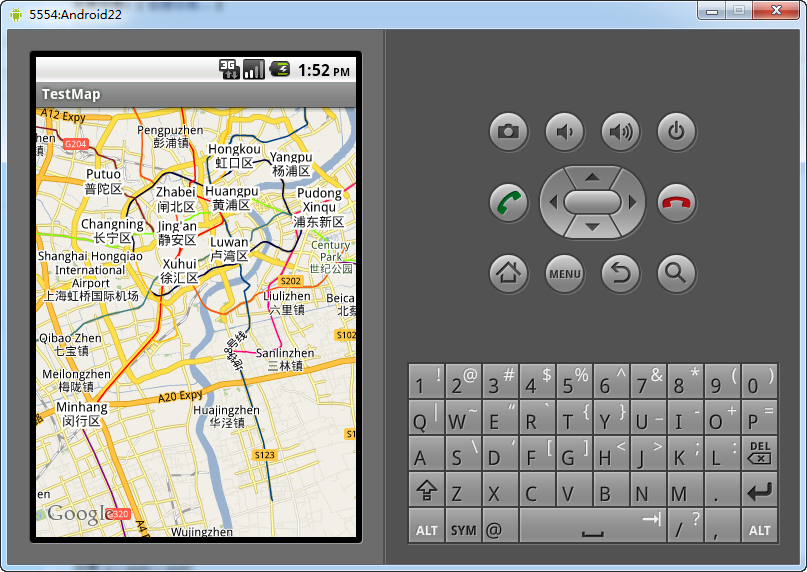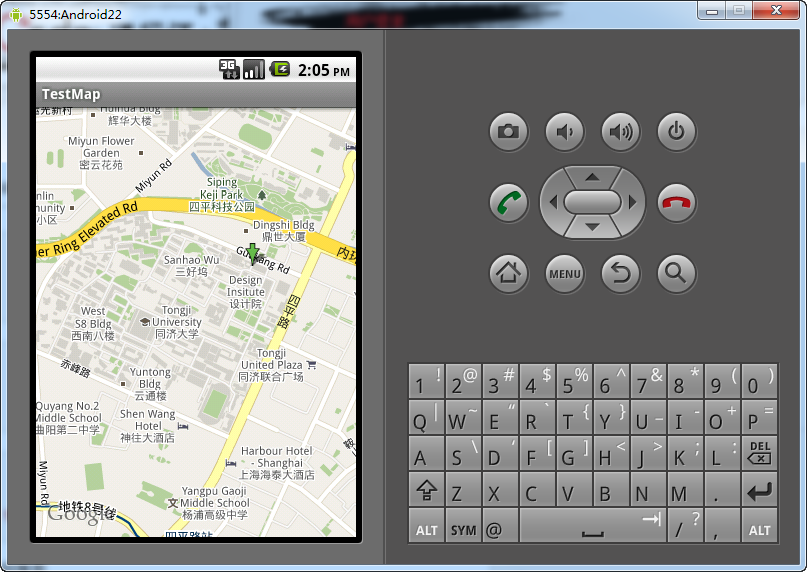地理编码(Geocoding)与地理反编码(Reverse Geocoding)是地图操作中的常见操作,前者表示通过街道地址请求空间坐标,后者表示通过空间坐标请求街道地址。通俗的说,二者就是街道地址与经纬度的转换。举例来说,前者就是输入查询"上海市杨浦区四平路1239号"得到(31.285207060526762, 121.50546412914991),而后者则表示这个反过程。
在实际的移动开发过程中,地图相关的操作对于地理编码与地理反编码的使用都是十分普遍。幸运的是,Android的MapView控件中对于这两者都进行了封装,因此可以方便的利用Google Map Service进行二者查询。下面将对开发过程做一个简单介绍。
首先必须进行MapKey的申请,任何地图的显示都需要申请一个MapKey。具体的申请步骤可见
http://code.google.com/intl/zh-CN/android/maps-api-signup.html
然后可以建立一个基于Google APIs的程序,并且在AndroidManifest.xml中加入地图API的支持。
view plaincopy to clipboardprint?
<?xml version="1.0" encoding="utf-8"?>
<manifest xmlns:android="http://schemas.android.com/apk/res/android"
package="net.learn2develop.GoogleMaps"
android:versionCode="1"
android:versionName="1.0.0">
<application android:icon="@drawable/icon" android:label="@string/app_name">
<uses-library android:name="com.google.android.maps" />
<activity android:name=".MapsActivity"
android:label="@string/app_name">
<intent-filter>
<action android:name="android.intent.action.MAIN" />
<category android:name="android.intent.category.LAUNCHER" />
</intent-filter>
</activity>
</application>
<uses-permission android:name="android.permission.INTERNET" />
</manifest>
</xml>
<?xml version="1.0" encoding="utf-8"?>
<manifest xmlns:android="http://schemas.android.com/apk/res/android"
package="net.learn2develop.GoogleMaps"
android:versionCode="1"
android:versionName="1.0.0">
<application android:icon="@drawable/icon" android:label="@string/app_name">
<uses-library android:name="com.google.android.maps" />
<activity android:name=".MapsActivity"
android:label="@string/app_name">
<intent-filter>
<action android:name="android.intent.action.MAIN" />
<category android:name="android.intent.category.LAUNCHER" />
</intent-filter>
</activity>
</application>
<uses-permission android:name="android.permission.INTERNET" />
</manifest>
</xml>
接着可以在主Layout文件中加入对于地图的显示,这里需要加入刚才申请的MapKey,否则地图将无法正常显示。
view plaincopy to clipboardprint?
<?xml version="1.0" encoding="utf-8"?>
<RelativeLayout xmlns:android="http://schemas.android.com/apk/res/android"
android:layout_width="fill_parent"
android:layout_height="fill_parent">
<com.google.android.maps.MapView
android:id="@+id/mapView"
android:layout_width="fill_parent"
android:layout_height="fill_parent"
android:enabled="true"
android:clickable="true"
android:apiKey="MapKey"
/>
</RelativeLayout>
<?xml version="1.0" encoding="utf-8"?>
<RelativeLayout xmlns:android="http://schemas.android.com/apk/res/android"
android:layout_width="fill_parent"
android:layout_height="fill_parent">
<com.google.android.maps.MapView
android:id="@+id/mapView"
android:layout_width="fill_parent"
android:layout_height="fill_parent"
android:enabled="true"
android:clickable="true"
android:apiKey="MapKey"
/>
</RelativeLayout>
接着在主Activity的JAVA文件进行修改,支持地图显示。
view plaincopy to clipboardprint?
import com.google.android.maps.MapActivity;
import com.google.android.maps.MapView;
import android.os.Bundle;
public class MapsActivity extends MapActivity
{
/** Called when the activity is first created. */
@Override
public void onCreate(Bundle savedInstanceState)
{
super.onCreate(savedInstanceState);
setContentView(R.layout.main);
MapView mapView = (MapView) findViewById(R.id.mapView);
mapView.setBuiltInZoomControls(true);
}
}
import com.google.android.maps.MapActivity;
import com.google.android.maps.MapView;
import android.os.Bundle;
public class MapsActivity extends MapActivity
{
/** Called when the activity is first created. */
@Override
public void onCreate(Bundle savedInstanceState)
{
super.onCreate(savedInstanceState);
setContentView(R.layout.main);
MapView
m
apView = (MapView) findViewById(R.id.mapView);
mapView.setBuiltInZoomControls(true);
}
}
此时运行程序,地图应该就可以正常显示了,见下图。

此时我们再向程序中加入地理编码与地理反编码的功能,其参考代码如下。
地理编码:
view plaincopy to clipboardprint?
Geocoder geoCoder = new Geocoder(this, Locale.getDefault());
try {
List<Address> addresses = geoCoder.getFromLocationName(
"上海市杨浦区四平路1239号", 5);
String add = "";
if (addresses.size() > 0) {
p = new GeoPoint(
(int) (addresses.get(0).getLatitude() * 1E6),
(int) (addresses.get(0).getLongitude() * 1E6));
mc.animateTo(p);
mapView.invalidate();
}
} catch (IOException e) {
e.printStackTrace();
}
Geocoder geoCoder = new Geocoder(this, Locale.getDefault());
try {
List<Address> addresses = geoCoder.getFromLocationName(
"上海市杨浦区四平路1239号", 5);
String add = "";
if (addresses.size() > 0) {
p = new GeoPoint(
(int) (addresses.get(0).getLatitude() * 1E6),
(int) (addresses.get(0).getLongitude() * 1E6));
mc.animateTo(p);
mapView.invalidate();
}
} catch (IOException e) {
e.printStackTrace();
}
地理反编码,其中MapOverlay为地图图层上的叠加图层,用于标识的显示以及点击事件的捕捉。
view plaincopy to clipboardprint?
class MapOverlay extends com.google.android.maps.Overlay
{
@Override
public boolean draw(Canvas canvas, MapView mapView,
boolean shadow, long when)
{
//...
}
@Override
public boolean onTouchEvent(MotionEvent event, MapView mapView)
{
//---when user lifts his finger---
if (event.getAction() == 1) {
GeoPoint p = mapView.getProjection().fromPixels(
(int) event.getX(),
(int) event.getY());
Geocoder geoCoder = new Geocoder(
getBaseContext(), Locale.getDefault());
try {
List<Address> addresses = geoCoder.getFromLocation(
p.getLatitudeE6() / 1E6,
p.getLongitudeE6() / 1E6, 1);
String add = "";
if (addresses.size() > 0)
{
for (int i=0; i<addresses.get(0).getMaxAddressLineIndex();
i++)
add += addresses.get(0).getAddressLine(i) + "\n";
}
Toast.makeText(getBaseContext(), add, Toast.LENGTH_SHORT).show();
}
catch (IOException e) {
e.printStackTrace();
}
return true;
}
else
return false;
}
}
class MapOverlay extends com.google.android.maps.Overlay
{
@Override
public boolean draw(Canvas canvas, MapView mapView,
boolean shadow, long when)
&
nbsp; {
//...
}
@Override
public boolean onTouchEvent(MotionEvent event, MapView mapView)
{
//---when user lifts his finger---
if (event.getAction() == 1) {
GeoPoint p = mapView.getProjection().fromPixels(
(int) event.getX(),
(int) event.getY());
Geocoder geoCoder = new Geocoder(
getBaseContext(), Locale.getDefault());
try {
List<Address> addresses = geoCoder.getFromLocation(
p.getLatitudeE6() / 1E6,
p.getLongitudeE6() / 1E6, 1);
String add = "";
if (addresses.size() > 0)
{
for (int i=0; i<addresses.get(0).getMaxAddressLineIndex();
i++)
add += addresses.get(0).getAddressLine(i) + "\n";
}
Toast.makeText(getBaseContext(), add, Toast.LENGTH_SHORT).show();
}
catch (IOException e) {
e.printStackTrace();
}
return true;
}
else
return false;
}
}
最终实现结果如下图所示,地理编码,查询“上海市杨浦区四平路1239号”,结果其实略有偏差。中国的地址与邮编比较混乱,所以结果有些地方无法做到完全准确。

地理反编码

本文来自CSDN博客,转载请标明出处:http://blog.csdn.net/syy6/archive/2010/07/05/5714631.aspx
